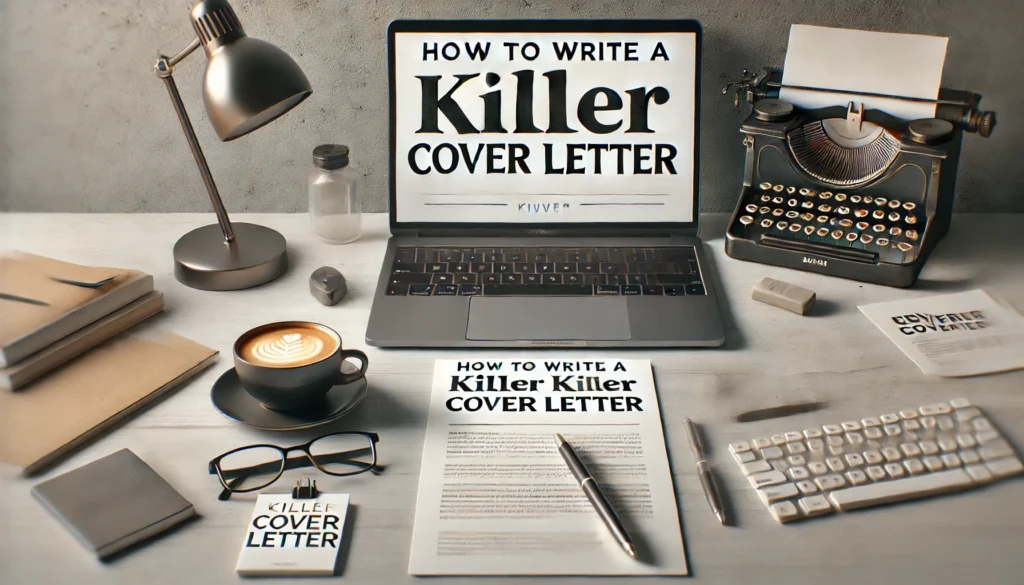A killer cover letter—it’s what every job seeker wants to craft, yet many find it difficult to master. A cover letter is more than a mere formality; it’s a powerful marketing tool that, when done right, can set you apart from the competition. In a world where employers often have piles of resumes to sift through, your cover letter is your chance to shine, to tell your story, and to make a compelling case for why you’re the best fit for the position.

But what exactly goes into making a killer cover letter? What are the secrets that turn a standard cover letter into one that grabs the hiring manager’s attention and lands you that crucial interview? In this article, we’ll dive deep into the components of a killer cover letter, exploring how to make every word count. With actionable tips and real-world examples, this guide will walk you through crafting a cover letter that truly impresses.
Table of Contents
Why a Killer Cover Letter Matters
It’s tempting to think of a cover letter as just a formality. After all, you’ve already sent your resume. But while your resume provides the factual details of your work history, a killer cover letter gives those facts context, bringing your experiences and skills to life. It lets you show off your personality and explain how you’d be an asset to the company.
Many hiring managers look at the cover letter as an indicator of your interest in the role. A generic cover letter can signal a lack of effort, while a personalized, killer cover letter can demonstrate your genuine enthusiasm and dedication. This could make the difference between landing an interview or getting passed over.
Key Elements of a Killer Cover Letter
Creating a killer cover letter isn’t about using complex words or flowery language. It’s about understanding the job, tailoring your message, and presenting yourself as the solution to the employer’s needs. Here are the key elements that can transform your cover letter from average to extraordinary:
1. A Strong Opening
The first sentence of your cover letter should grab the reader’s attention immediately. Start with a powerful statement about why you’re interested in the role or a bold claim about what you bring to the table. For example:
“With over five years of experience in digital marketing and a proven record of increasing client engagement by 30%, I’m excited about the opportunity to bring my expertise to your team.”
A killer cover letter doesn’t start with “I am applying for the position of…” Instead, it dives straight into why you’re the perfect fit.
2. Research the Company and Job Role
A killer cover letter shows that you’ve done your homework. Tailor each cover letter to the specific job and company you’re applying to. Mention something specific about the company’s mission, values, or recent achievements. This shows that you’re genuinely interested in the organization, not just in any available job.
3. Highlight Relevant Skills and Experiences
Your cover letter should highlight the skills and experiences that align with the job description. If a company is looking for someone with project management skills, don’t just mention that you have those skills—share a specific example. This will demonstrate how you’ve successfully applied your skills in the past, making you a more memorable candidate.
4. Show Enthusiasm and Passion
Passion and enthusiasm can’t be faked in a killer cover letter. Express your excitement about the role and the company. Explain what draws you to this position and why you think you’re a great fit for the team. Employers are often drawn to candidates who genuinely care about the work.
5. Use Concrete Examples
A killer cover letter doesn’t rely on vague statements. Instead, it uses specific examples to illustrate points. For instance, if you’re applying for a customer service role, instead of saying “I’m good at resolving conflicts,” you could say, “In my previous role, I successfully de-escalated a situation with an unhappy client, resulting in positive feedback from the client and my supervisor.”
Concrete examples make you more memorable and show that you can apply your skills effectively in real-world situations.
6. Address the Hiring Manager Personally
Whenever possible, address your cover letter to the specific hiring manager. “Dear Hiring Manager” is functional, but a killer cover letter includes the hiring manager’s name. It shows that you’ve done your research and are taking the application process seriously.
If the name isn’t listed in the job posting, consider looking on the company’s website or LinkedIn to find out who might be handling the hiring process. This extra step can make your letter feel more personal and targeted.
7. Keep It Concise and Focused
While it might be tempting to go into great detail about your accomplishments, remember that hiring managers don’t have time to read lengthy cover letters. A killer cover letter is concise and focused, generally no longer than one page. Use clear and direct language, and cut out any fluff or unnecessary details.
8. End with a Strong Closing Statement
Your closing statement should reiterate your enthusiasm for the role and prompt the hiring manager to take the next step. Consider ending with something like, “I am thrilled at the prospect of bringing my skills to your team and contributing to your company’s success. I look forward to the opportunity to discuss how my background and skills align with your needs.”
This type of closing statement reinforces your interest and leaves a positive, memorable impression.
Common Mistakes to Avoid in a Killer Cover Letter
Even a potentially killer cover letter can fall flat if you make certain mistakes. Here are a few to watch out for:
- Being Too Generic: Avoid using the same cover letter for multiple job applications. Tailoring your letter makes a big difference.
- Repeating Your Resume: Your cover letter should add value by providing context to your resume, not just repeating the information.
- Making It Too Long: Keep it brief and to the point. A killer cover letter should be no more than a single page.
- Not Proofreading: Grammar or spelling errors can hurt your chances, even if your content is strong.
Real-World Example of a Killer Cover Letter
Here’s an example to give you a clearer idea of what a killer cover letter might look like:
Updateminds
123 Main St, City, State, Zip Code
updateminds@email.com
(123) 456-7890
[Today’s Date]
Hiring Manager’s Name
Company Name
Company Address
City, State, Zip Code
Dear [Hiring Manager’s Name],
As a highly motivated marketing professional with over six years of experience in driving online engagement and a track record of exceeding goals, I am excited about the opportunity to join [Company Name] as a Digital Marketing Specialist. I have long admired [Company’s recent achievement or quality], and I am confident that my passion for strategic marketing and proven results-driven approach align well with your team’s goals.
In my current role at [Current Company], I spearheaded a campaign that increased brand engagement by 35% within three months, reaching new audiences while reducing costs. My analytical skills, combined with my ability to craft targeted campaigns, would allow me to contribute meaningfully to [Company’s Specific Goal]. Additionally, I thrive in collaborative environments where I can contribute new ideas and grow alongside dedicated professionals.
Thank you for considering my application. I look forward to discussing how my background and skills can help [Company Name] achieve continued success.
Warm regards,
Updateminds
Final Tips for Crafting Your Own Killer Cover Letter
Creating a killer cover letter takes effort and practice, but with the right approach, you can create something that truly sets you apart. Here are a few final tips to keep in mind:
- Use Active Language: Words like “led,” “implemented,” and “achieved” convey a sense of action and accomplishment.
- Be Authentic: Write in your natural voice. A killer cover letter feels authentic and genuine.
- Focus on Value: Keep the focus on what you can bring to the company, rather than just what you’re looking for in a job.
By following these steps, you’ll be well on your way to creating a killer cover letter that grabs attention and lands you interviews. Happy job hunting!
FAQ
What is a killer cover letter?
A killer cover letter is a tailored, impactful letter that highlights your skills, experiences, and fit for the job, making you stand out to employers.
Why is a cover letter important?
A cover letter gives context to your resume, shows your enthusiasm for the role, and allows you to explain why you’re the best fit for the position.
What should a killer cover letter include?
Key elements include a strong opening, relevant skills, tailored examples, enthusiasm for the role, and a compelling closing statement.
How long should a killer cover letter be?
A killer cover letter should be concise, ideally one page, focusing on key points and avoiding unnecessary details.
What are common mistakes to avoid in a cover letter?
Avoid being generic, repeating your resume, making it too long, and skipping proofreading, as these can make your letter less effective.



